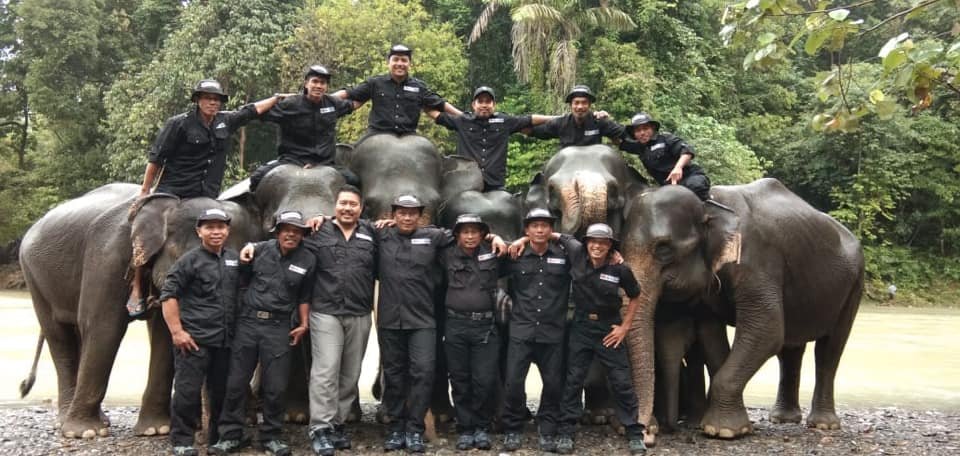Human-Elephant Conflict
As prime elephant habitats are shrinking across Asia and human developments are on the rise, both species are increasingly coming into close contact. Human-elephant conflicts (HEC) arise with complex interactions between humans and elephants often resulting in detrimental impacts for both species. Human elephant conflict arises in many ways across the thirteen Asian elephant range countries:
Crop raiding and property damage: Almost all elephant habitat is surrounded by farmland where locals earn their living and often reside. Farmlands adjacent to elephant habitats are often prone to crop raiding from nearby elephants. In many cases, these farmlands are created by clearing prime elephant habitat. Despite the clearing of habitat, elephants continue to forage into these farmlands, often causing damage to crops worth thousands to millions of dollars. Small and economically vulnerable farmers in the surrounding areas suffer greatly as their livelihood might be destroyed by a herd of elephants in a single night. The situation is exacerbated when farmers plant crops that elephants like to eat such as sugarcane, maize, and vegetables. The easy access and availability to relatively high-content and nutritious food in farms make the farms very lucrative option compared to forests.
Injuries and deaths to humans: Human encroachment continues to grow around elephant habitats across Asia. Nearly 20% of the world’s population lives in or near Asian elephant habitats and ranges. With increasing human populations in elephant range countries, there are ever-growing demands for space and water. This often results in humans settling in areas which are part of elephant migratory paths or part of elephant home range areas. In many cases, humans encroach areas adjacent to water resources, depriving elephants from access to water. With human development comes the growth in infrastructures. Often dams, roads, and railway lines are put in place in area which were once elephant habitats. There are numerous examples of elephant habitats being fragmented as a result of human settlement and developments. Asian elephants, being migratory animals, rely on matriarchs to lead their herds through ancient migratory routes for food and water. When ancient routes are hindered by humans, the results have been quite devastating. Cases of elephant herds raiding villages and causing serious injuries and deaths to humans are becoming increasingly common. According to WWF, over 100 people are killed every year in India and hundreds are seriously injured.
Retaliatory killings: Retaliatory killings of African and Asian elephants are becoming increasingly common. When elephants raid crops and destroy villages, they are viewed as nuisance, danger, and risks to livelihoods for farmers and villages. The result is often detrimental for elephants. Every year, hundreds of elephants are killed in retaliation through shooting, electrocution, and poisoning in Asian elephant range countries. There have also been cases of illegal captures as retaliatory measures. Human negligence has also lead to number of deaths in India. Over the past five years, in eastern India, over 100 elephants have been electrocuted by hanging electricity wires.
Poaching for ivory: Poaching is not as significant threat for Asian elephants as it is for their wild cousins in Africa. However, Asian elephants are also poached across many range countries for their ivory, meat, and other parts. Some Asian countries have an ivory carving tradition going back to over 500 years and there has been a continuous demand for African and Asian elephant ivory. Studies have shown that ivory poaching was responsible for between 44 and 68% of all male elephant deaths in several Indian regions. There is also evidence suggesting a similar off take of male Asian elephants in other parts of Southeast Asia in countries such as Thailand, Cambodia, Vietnam, and Laos. This can have a long-term impact on future elephant populations as off take of male elephants leads to imbalance in the population demographics. There is also a strong demand of elephant body parts in many Eastern Asian countries for their usage in traditional Asian medicines. Studies have suggested that there is no scientific evidence for benefits from such body parts usage for medicinal purpose.
Written by AES education volunteer, Shri Goswami
What WE ARE Doing
Members of the Tangkahan Conservation Response Unit in Sumatra with their team of elephants that help patrol the national park
Asian Elephant Support funds a variety of programs throughout Asia, aimed at mitigating human-elephant conflict. Programs include community theater projects that educate people living in or around elephant habitat on how to avoid conflict with wild animals, fencing projects designed to keep crop-raiding elephants out of farmlands and collaring and mapping projects that allow rangers to track the movements of wild elephant herds to better understand how to protect surrounding communities. AES is also proud to support Elephant Response Units in various countries, including Sumatra. Using highly-trained elephants, these professional rangers patrol national parks and reserves, to ensure wild elephants stay safely within the boundaries of protected areas, monitor for illegal poaching operations and may at times give assistance in providing medical care to injured or ill wild elephants.
A ranger with the Elephant Response Unit sits atop of his highly trained elephant, monitoring a wild herd of elephants in Way Kambas National Park, Sumatra.


